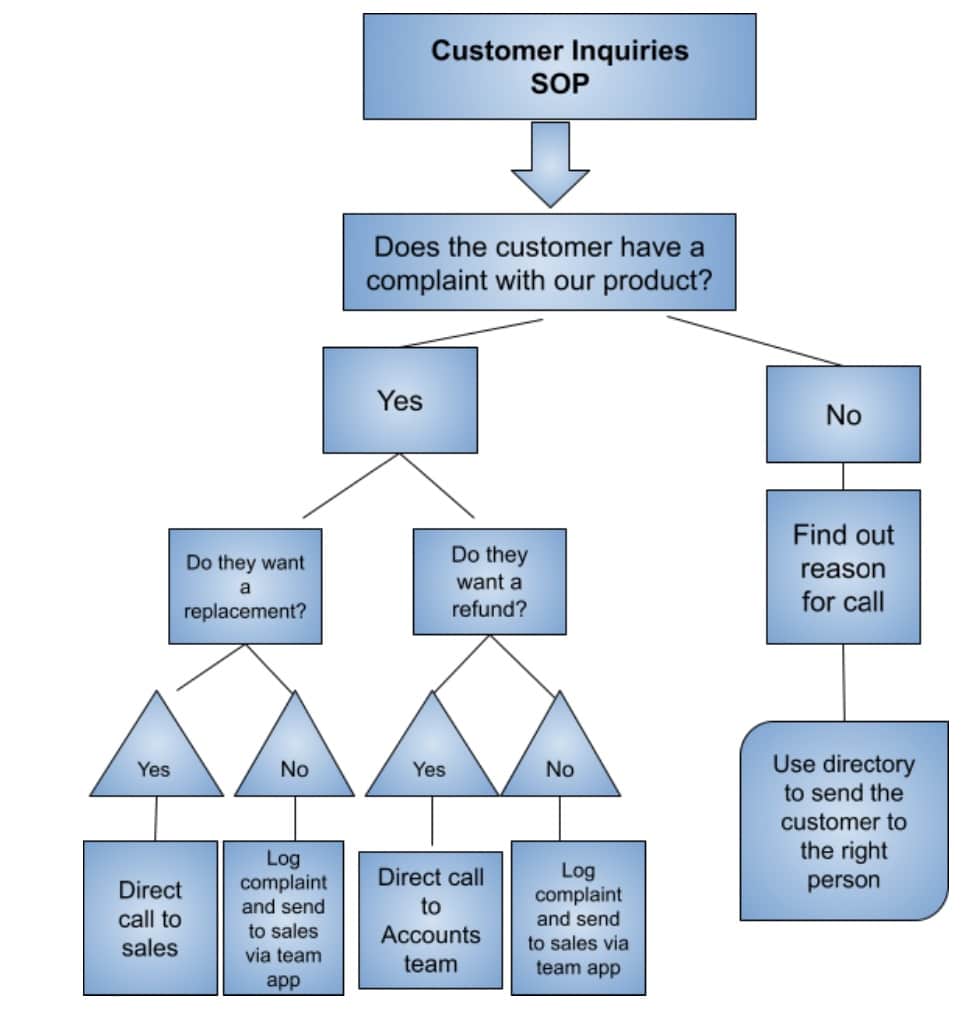At its core, a business is a series of processes. If there’s one document that should be the go-to for how to get things done, it’s a standard operating procedure, or SOP. Companies create these internal guides to create lean, efficient, and uniform workflows.
Learn how a digital workplace is the most efficient way to create and distribute checklists to your frontline teams.
Imagine having a roadmap that guides your team through every task, ensuring lean and efficient processes. That’s why companies create SOPs for different internal procedures. In this article, we’ll help you create, share and templatize these checklists with your frontline team.
What Is a SOP Document?
An SOP, or Standard Operating Procedure, outlines the step-by-step processes to perform tasks consistently and efficiently. It serves as a playbook for employees, ensuring everyone understands and follows the same methods, reducing errors and enhancing quality.
For example, a restaurant might use an SOP to ensure every chef prepares a dish the exact same way, preserving quality and customer satisfaction. Manufacturing companies might write a SOP for employee training to reduce risks and incidents and ensure a safer workplace.
The Purpose of an SOP in Business
SOPs create consistency of process in order to deliver expected outcomes. They help companies run more efficiently and ultimately save money. For example, manufacturers can create standard operating procedures for line workers to manage machine maintenance. Having a daily checklist can avoid unplanned downtime due to equipment failure.
The general purpose of a SOP document is to:
- Align workers on workflow steps for consistency
- Reduce chances for costly errors due to miscommunication
- Stay on schedule
- Ensure compliance, i.e. food manufacturers must follow FDA regulations
- Reduce product recall rates
- Improve operational efficiency
- Save money
A SOP is distributed to all relevant employees that are affected or involved in the specific process. In a frontline business, digitally distributing the SOP ensures everyone is able to receive the same information.
What Is a SOP Template?
A company might have a number of SOPs, written by different people, reflecting methods of completing a variety of assignments. A standard operating procedure template is a preformatted document that a company uses as a starting point to write a SOP. Like any template, this one serves as a basic structural guideline for creating operating procedures.
A template creates a single style, so every one of the documents is structurally consistent. A template dictates what information needs to be in the document and placement of each topic within the SOP. This consistency from one SOP to the next helps users easily find the information they need.
Components of a General SOP in Business
Building a template makes it easy to write SOPs for every task that needs one. The first step is to set a style and layout. From fonts to line spacing to sections, build a framework that you can build on for every different SOP so the flow of information is the same in each one.
The primary components of a SOP are:
- Title: Clearly states the purpose of the SOP and may include the department or team name. It should be specific enough to be distinguishable from other SOPs.
- Identification/Code Number: A unique reference number or code assigned to the SOP for easy tracking and organization.
- Revision Date: Indicates the last date the SOP was reviewed or updated, ensuring users are aware of the most current version.
- Purpose: A brief statement explaining the aim and expected outcome of the SOP, clarifying why the procedure is important and who it benefits.
- Scope: Defines the boundaries of the SOP, detailing where and when it applies, as well as who should follow it.
- Responsibilities: Outlines the roles and responsibilities of individuals or teams involved in the process, ensuring clarity on who does what.
- Glossary/Terminology: A list of terms and definitions used within the SOP, providing clarity and ensuring a common understanding of specific language or acronyms.
- Procedures: The core component detailing the step-by-step instructions needed to complete the task effectively. This section may include equipment needed, safety precautions, and quality standards.
- Quality Assurance/Control Measures: Details any checkpoints or metrics to ensure the task is performed to a certain standard.
- References and External Links: Provides additional resources, related documents, or external standards that support the SOP or are necessary for its implementation.
- Appendices: Supplementary material that may include forms, templates, or additional information relevant to the SOP.
- Distribution List: Specifies who needs to have access to the SOP, often including various departments or specific roles within the organization.
- Approval Signatures: Signatures or acknowledgments from the relevant authorities or department heads, indicating the SOP has been reviewed and authorized.
Standard Operating Procedure Example
Using those primary components, here is an example of what a standard operating procedure looks like.
| Title: Quarterly Cybersecurity Protocol Update Identification/Code Number: SOP-IT-001 Revision Date: December 27, 2023 Purpose: To systematically update and reinforce the company’s cybersecurity measures to protect against new threats and vulnerabilities. Scope: This SOP applies to the IT Department, specifically to the Cybersecurity and Network Teams, and affects all company network users. Responsibilities:Chief Information Security Officer (CISO): Oversee the protocol update process, final approval of changes, and compliance with legal standards.Cybersecurity Team: Research new threats, develop updates to protocols, and test new security measures.Network Team: Implement changes across the company’s network and assist in enforcing new protocols.IT Support Staff: Provide support and training to company employees on new security measures. Glossary/Terminology:Phishing: Fraudulent attempt to obtain sensitive information by disguising as a trustworthy entity.Malware: Any software intentionally designed to cause damage to a computer, server, client, or computer network. Procedures:Preparation Phase:Review and list all current cybersecurity measures.Research recent cybersecurity threats and trends.Development Phase:Develop updates to existing protocols or new protocols as necessary.Create a testing plan for the new updates.Testing Phase:Implement updates in a controlled environment.Monitor for stability and any unforeseen vulnerabilities.Training Phase:Develop training materials for IT staff and end-users.Schedule and conduct training sessions.Implementation Phase:Roll out updates across the network during a low-usage period.Monitor the network closely for any issues arising from the update.Post-Implementation Review:Collect feedback from IT staff and end-users.Make necessary adjustments based on feedback. Quality Assurance/Control Measures: Each update must pass a security effectiveness test before full implementation. Post-implementation, a network vulnerability scan must be performed to ensure no new security risks have been introduced. References and External Links:Industry Best Practices for CybersecurityRecent Cybersecurity Research Papers Appendices:Detailed Update LogsTraining Presentation SlidesFeedback Forms for Post-Implementation Review Distribution List:All IT Department StaffCompany ManagementAny department affected by network changes Approval Signatures:[CISO Name][Head of IT Name] |
Common types of SOP in Business
Once you know the workflow you need an SOP for, you need to choose how to present the information. There are several formats to choose from, each designed to boost operational productivity of an organization. And different formats are good for different scenarios. Here are four of the most common types of SOPs.
1. Checklists
Checklists are a list of tasks that need to be accomplished for a specific workflow and can be ticked off as completed. They provide a structured approach to emergency procedures or critical tasks like equipment shutdowns, data breaches, or customer service escalations.
A part of a housekeeping checklist might look like this:
| Housekeeping Checklist for Guest Rooms Objective: Ensure guest rooms are clean, comfortable and well-stocked Scope: Applicable to all housekeeping staff Frequency: Daily or upon guest checkout Checklist: Bedroom ✅ Replace linens and make the bed ✅ Empty trash and replace liner Bathroom ✅ Replace towels with clean sets ✅ Clean shower, sink and toilet ✅ Restock toiletries and toilet paper General ✅ Vacuum floors ✅ Dust surfaces ✅ Refill amenities Note: Use protective gear and follow safety guidelines |
2. Step-by-Step Lists
The most basic format is just a step-by-step list of action items. It is a straightforward bulleted list of tasks, often in sequential order.
Here is an example of part of a step-by-step list of submitting expense reports:
| EXPENSE REPORTS & REIMBURSEMENTS SUBMITTAL Purpose: Employees who travel or incur costs on behalf of the company must complete an expense report to get reimbursed and for the company to accurately track expenses. Scope: Applicable to all employees Use the expense sheet template on your employee app to add itemsUpload images of your receipts to the reportPopulate all cells of date, reason, amount of spendingHit the Submit button to send expense report to accounting |
3. Hierarchical Lists
For more complex tasks, a hierarchical list might be more appropriate. The layout is more detailed and allows more room for “sub” tasks within each line item.
In project management, a hierarchical list could detail the steps for initiating a new project. The main step might be “Project Initiation,” with sub-steps like 1(a) defining the project scope, 1(b) identifying key stakeholders, 1(c) setting project objectives, and so on. This structure helps clarify complex processes with multiple layers.
A hierarchical list might look like this:
| Project initiation: – Notify stakeholders of kickoff meeting – Create project scope document a) Define project scope b) Identify key stakeholders c) Set project objectives |
4. Process Flowcharts
Flowcharts are a visual representation of a process or procedure. This format is a great option when there are different yes/no answers or scenarios that will dictate the next step.
A process flowchart might be used for customer service procedures, visually mapping out the steps customer service representatives should follow when handling different types of customer inquiries or complaints.
A flowchart might look like this:

10 Steps to Creating an Effective SOP
When it comes to operations, leaders should determine which processes are complex enough to benefit from written specifications. Effective SOPs streamline processes to make room for innovation. The more efficient internal processes become, the less money is spent and greater capital is available to put into growth initiatives.
Here are 10 top tips for creating an effective SOP:
1. Identify your audience and determine your goals.
The first step is identifying who the SOP is for and what the ultimate goal is. Your audience could range from new hires to seasoned professionals, each with different levels of familiarity with the process at hand. Recognizing this diversity can help you tailor the tone, language and complexity of the SOP.
Your goals also determine the purpose of the SOP. Are you looking to streamline a process, ensure compliance with regulations or minimize errors? Defining these objectives can guide the content and structure of your SOP, making it focused and effective.
2. Assemble Your Team & Determine the Stakeholders
Next, determine the stakeholders: who will be involved in creating the SOP and who will the SOP impact. This is often C-Suite leadership team members, HR, managers, and also the employees will be doing the work outlined in the document.
While many SOPs are designed for internal workflows, there are some that are meant to guide workers through customer engagement experiences. In those cases, consider the customer to be another stakeholder and take their perspective into mind when crafting the document.
3. Gather All Necessary Information.
Before crafting a SOP, you need to do some legwork to make sure it contains all of the necessary information and steps. Interview the employees who will use it to make sure you’re covering every step in the process. This is easy with an internal communications app like Beekeeper that can easily connect with any employee via their mobile device. Ask for feedback on any SOP drafts, and for employee contributions to the SOP so they have ownership in the process, too.
4. Fine-tune the Details & Determine the Scope and Format
Begin to lay out the steps of the SOP in detail, keeping clear of assumptions that might confuse those less familiar with the task. Present these steps in a logical sequence so that the procedures are executed correctly.
Your SOP should be tailored to both the task at hand and the intended audience.While housekeeping will benefit from a checklist, a flowchart might work better for a manufacturing team for predictive maintenance tasks.
5. Define Success
You’re crafting an SOP for a very specific purpose. Yes, it’s to create efficiency but each workflow is like a narrative: what is the end that will define success? For a manufacturing checklist it might mean a higher quality product made faster and for less money. Always keep the end goal in mind and make sure to track the results to make sure you’re hitting those targets.
6. Write the SOP with Clear and Concise Instruction
SOPS are not essays. They exist to create to-the-point instructions meant to achieve specific goals.
- Break the process down logically: Walk through the process and break the steps down in sequential order. Make sure you don’t forget any steps or information.
- Eliminate Ambiguity:Your goal is to be as clear and concise as possible in an SOP. Use simple language and be brief. Use the active voice to engage your employees. Begin instructions with command verbs. For example, “Clean the machine after every use.”
- Get Stakeholders to Review: Engage your stakeholders in reviewing and editing the document to ensure it is comprehensive yet concise.
7. Test, Train, and Tweak the SOP in Practice
Make sure to do several trial runs before implementing the SOP. Test out your SOP by asking subject matter experts, often people who regularly perform this task, to run through the steps. Repeat again with someone unfamiliar with the task to test the clarity and flow of the SOP and to see if it achieves stated goals.
8. Implement SOP in Business
Now that you’ve crafted your SOP, it’s time to put it into action! First, let everyone in your company know about the new SOP and where they can find it. Create a SOP stream on your mobile communication tool to ask for feedback and make changes accordingly.
9. Provide Access—Distribute SOPs digitally
In today’s workplace, the most effective way to distribute SOPs is through a mobile workplace app which gives every employee access to the document on their mobile device. They can easily pull it up whenever they need it. An employee app will also have a read receipt function to ensure relevant stakeholders have received—and opened—the SOP.
10. Continuously Review and Update SOPs
Workflows and operations are constantly evolving. Make sure your SOPs are reviewed and updated regularly to reflect change in processes and procedures. Make sure to create a two-way feedback loop to encourage employees to keep you posted on any changes that could improve the SOP and ultimately the whole workflow.
Communication Challenges with SOPs—and How to Overcome Them
Writing SOPs seems straightforward, but there are a few communication stumbling blocks you might encounter as you craft them. Here are five common challenges in writing effective SOPs and how to avoid them.
- Unclear SOP: You don’t want anyone asking, “so, what do I do?” after reading your SOP. Use action-oriented language in each step-by-step guide. Have your in-house communication team write your SOPs. Don’t have one? Then hire a freelance writer familiar with the purpose and style of SOPs.
- Convoluted SOP: You’re not writing Homer’s The Odyssey here! Remember: SOPs are meant to be to-the-point guidelines that are easy to read and easy to follow. Be brief and direct and use visuals and flow charts.
- Incorrect SOP:Accuracy is key to writing SOPs. Make sure they work with the employees who are intimately familiar with the task so steps are outlined correctly and nothing is missed.
- Outdated SOP: An employee pulls up a standard operating procedure only to find that the equipment has been updated, but the SOP has not. Make sure your SOPs are continually reviewed and reflect any changes to the process and procedures.
- Inaccessible SOP:SOPs are only effective if employees can find them! Ideally, SOPs are digitized and accessible on an employee app so users can access them right on their mobile device exactly when they need them. This is particularly important in a frontline workspace in which employees are not working at a desk and need access to SOPs while on the move.
Best Practices When Rolling Out New SOPs
You’ve written a new SOP…now what? It’s time to get it out to your team! Here are five best practices to implement standard operating procedures:
- Let everyone know when you release a new SOP: When a new SOP is ready, let your teams know. Send out a message to all relevant employees so they know it’s available and they’re expected to follow it.
- Be open to questions and feedback: SOPs are meant to be guides that create consistency and you want to make sure they’re correct. Make sure employees know that you want to hear from them. Is the SOP clear and easy to follow? Are any steps missing? Have employees message you with feedback.
- Make the SOP available to all: You don’t want SOPs just tucked away in a file drawer. You want them to be accessible to everyone. In organizations with a frontline workforce, put them in the document library of your mobile productivity tool so people can access them right on their mobile device whenever they need it.
- Offer training: SOPs might not be intuitive if a user is just starting to learn the task. Have a manager or a colleague run through the SOP with new employees or people just learning the workflow and demonstrate the process.
- Monitor and follow-up: Ask users to provide feedback through your company’s employee app in the first months after the rollout. This allows you to tweak any steps or language to maximize the effectiveness as early as possible.
Improve Your Workflow with an SOP Employee App
Your SOP for business might be a well-written, thorough document, but it’s only effective if it reaches your intended audience. A mobile-first tool like Beekeeper is the optimal way to distribute and store SOPs for real-time access by relevant stakeholders. They also allow easy reporting of completed tasks, allowing workers to record the completion of every action item.
Another benefit to digital SOPs is the information can be translated into the reader’s preferred language. A company with a diverse, multilingual workforce can easily share a checklist that everyone can easily follow. And with an app like Beekeeper with a robust marketplace, SOPs can easily be created to work with different software and solutions.
SOPs are a regular part of business operations. Maximize their effectiveness by taking the time to learn how to write a strong SOP.




